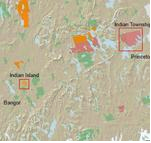were pursued in 1977, when the Penobscot, Passamaquoddy and Maliseet Indians sued the State of Maine claiming that all treaties granting land to Maine were null and void because they were never ratified by Congress.
According to William Cronin,
The Massachusetts Court made its ownership theories quite clear when it declared that “what landes any of the Indians, within this jurisdiction, have by possession or improvement by subduing of the same, they shall have just right thereunto, according to [the law].
The implications was that the Indians did not own any other kind of land: clam banks, fishing ponds, berry-picking areas, hunting lands, the great bulk of a village’s territory. (Since the non-agricultural Indians of the north had only these kinds of land, English theories assigned them no property rights at all.)
In 1980, a settlement for $81.5 million was agreed upon although the original claim was for $25 billion and 12.5 million acres of land. It was enacted by the Maine Legislature as Title 30, Chapter 601 Maine Indian Claims Settlement.
The money from the settlement was used by the Indians to buy land and property. The Passamaquoddies used some of their money to purchase a cement factory at Thomaston.
The federally recognized Indian lands in Maine are nicely presented on the map prepared by Caitlin Casey at Colby College. Click on the map at left to access the detailed presentation.
1980 Maine Indian Land Claims Settlement
Federal Funds
| Trust Funds Passamaquoddy | $12,500,000 |
| Trust Funds Passamaquoddy Elderly | $ 1,000,000 |
| Trust Funds Penobscot | $12,500,000 |
| Trust Funds Penobscot Elderly | $ 1,000,000 |
| Land Acquisition Passamaquoddy | $26,800,000 |
| Land Acquisition Penobscot | $26,800,000 |
| Land Acquisition Houlton Band Maliseet | $ 900,000 |
| Total: | $81,500,000 |
Additional resources
Casey, Caitlin (’09) “Federally Recognized Indian Lands of Maine,” Atlas of Maine: Vol. 2008: Iss. 1, Article 3. Available at: http://digitalcommons.colby.edu/atlas_docs/vol2008/iss1/3
Cronin, William. Changes in the Land: Indians, Colonists, and the Ecology of Northern New England. New York. Hill and Wang. 1983. p. 63.
Dieffenbacher-Krall, John. Report of the Tribal-State Work Group to Study Issues Associated with the Maine Implementation Act. Maine Indian Tribal-State Commission. 2006.
Maine. Legislature. “Title 30: FEDERALLY RECOGNIZED INDIAN TRIBES,
Part 4: INDIAN TERRITORIES, Chapter 601: MAINE INDIAN CLAIMS SETTLEMENT.”
https://legislature.maine.gov/legis/statutes/30/title30sec6205.html (accessed November 22, 2017)
“ME Land Claim.” Passamaquoddy Tribe at Pleasant Point. http://www.wabanaki.com/me_land_claim.htm (accessed December 26, 2011)
Pecoraro, Joseph. The Maine Indian Land Claims Case: Pro and Con. Augusta, Me. Maine Department of Educational and Cultural Services. 1979.
Scully, Diana. Maine Indian Claims Settlement: Concepts, Context, and Perspectives. Maine Indian Tribal-State Commission. 1995.
Symposium on Indian Law–the Eastern Land Claims. Portland, Me. University of Maine School of Law. 1979.
United States. Congress. House. Committee on Interior and Insular Affairs. Providing for the settlement of land claims of Indians, Indian nations, and tribes, and bands of Indians in the State of Maine, including the Passamaquoddy Tribe, the Penobscot Nation, and the Houlton Band of Maliseet Indians, and for other purposes: report to accompany H.R. 7919. Washington. U.S. Government Printing Office.1980
United States. Congress. House. Committee on Interior and Insular Affairs. Settlement of Indian land claims in the state of Maine: hearing before the Committee on Interior and Insular Affairs, House of Representatives, Ninety-sixth Congress, second session, on H.R. 7919. (hearing held in Washington, D.C., August 25, 1980) Washington. U.S. Government Printing Office. 1980 [i.e. 1981].


